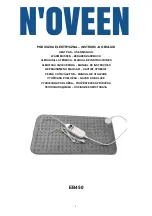
3. The maximum allowable length of vent pipe is 60 ft. This length includes the
combination of inlet air vent for combustion and exhaust venting. The RADIANT
TUBE IS NOT INCLUDED IN THIS MEASUREMENT. For every 90-degree bend in
the system, 5 ft. must be deducted from the allowable total.
4. W hen venting through a combustible wall or roof type “B” vent must be used for that
portion of the vent that passes through the wall or roof. FOR W ALL VENTING THE
MANUFACTURER’S APPROVED VENT TERMINAL MUST BE USED. THE USE
OF ANY W ALL VENT TERMINAL OTHER THAN THAT SUPPLIED BY THE
MANUFACTURER W ILL VOID W ARRANTIES. THE MANUFACTURER ACCEPTS
NO RESPONSIBILITY FOR DAMAGES CREATED BY USING OTHER VENT
TERMINALS.
5. All vent pipe used with a slip fit connection must be mechanically secured and all
vents must be supported every 3 ft.
6. Vent pipe of single wall construction shall not run through unheated spaces unless
insulated.
7. All vent pipes longer than 10 ft. must be insulated or have insulated type vent
material.
8.
Vents for products of combustion shall not terminate less than 3 ft. from a
combustion air inlet of any other appliance, less than 3 ft. from a building opening or
be directly above a gas utility meter or service regulator. On “U” model heaters the
vent terminal shall not be closer
than 4 inches from the combustion air inlet.
9. Vent terminals shall not be located less than 3 ft. above grade.
10. Horizontal vent systems shall slope downwards not less than ¼ inch per foot from
the start of the vent system to the vent terminal.
11. W hen installed in a large and adequately ventilated space (agricultural building used
only for brooding purposes) the heater may be installed un-vented without
interlocking, and may be operated by discharging the combustion products directly
into the space, subject to the approval of the authority having jurisdiction and
provided that the maximum input of the appliance does not exceed 20 BTUH/ft3 (0.2
kW /m3) of the space in which the heater is located. An appliance designed to
produce a controlled atmosphere need not be subject to these conditions.
WARNING
This heater will expand in length as it heats up. It is a normal condition that
during heat-up and cool-down a tube heater will expand and contract. Allowances for
heater expansion must be made in the gas connection, venting and combustion air
ducting. Improper installation, alteration, or adjustment can result in property
damage, injury or death.
The BTU input and the tube length determine the overall expansion that occurs.
A typical infrared tube installation will expand toward both the burner and the vent
end.
To allow heater expansion the gas supply must be installed using
:
In the USA: a stainless steel flexible gas connector certified for use on an
infrared radiant tube heater (ANSI Z21.24 CSA 6.10)
In Canada: a Type 1 hose connector (CAN/CGA 8.1). Also the flue vent, and
combustion air intake (if used) must be installed in such a manner that the normal
expansion of the heater will be accommodated.
Summary of Contents for PPRTH-50-15
Page 12: ......
Page 13: ......
Page 18: ......
Page 19: ......
Page 20: ......
Page 21: ......
Page 22: ......
Page 23: ......
Page 24: ......
Page 25: ......
Page 26: ......
Page 27: ......
Page 28: ......
Page 29: ......
Page 30: ......
Page 31: ......
Page 32: ......
Page 34: ...LISTED ACCESSORIES...
Page 35: ...AC1120 Tee 4 x4 x6...
Page 42: ......
Page 45: ......
















































